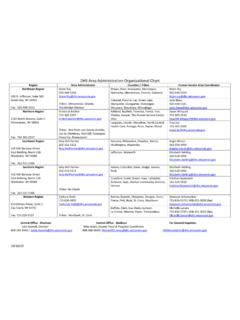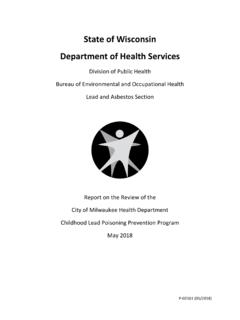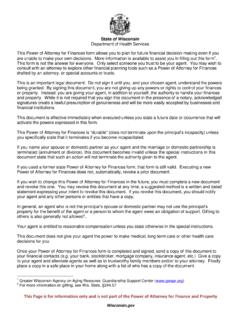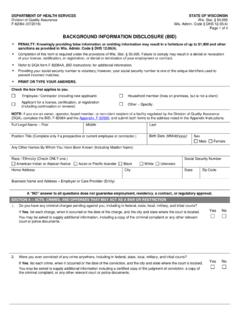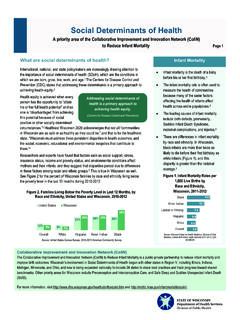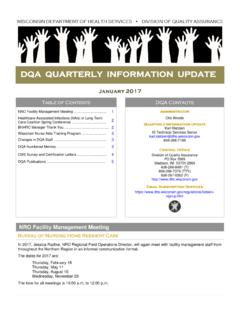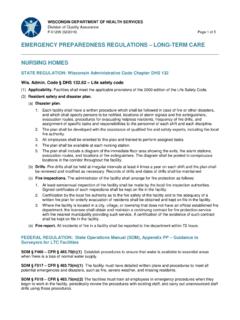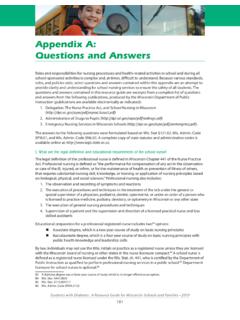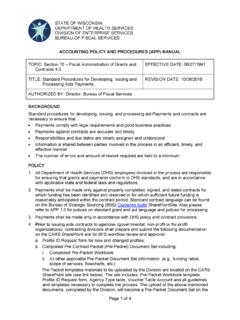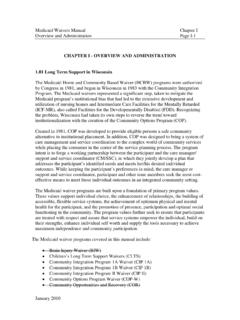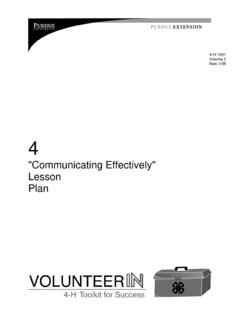Transcription of Typical and Atypical Childhood Development Module 1: …
1 Typical and Atypical Childhood Development Module 1: Birth through 3 Years of Age Matrices Page 1 of 13 Typical Developmental Milestones Atypical Development (Missing or Not Meeting Anticipated Milestone) Notes 2 MONTHS (Birth to Three Years Old) SOCIAL AND EMOTIONAL Begins to smile at people Doesn t smile at people Can briefly calm him/herself (may bring hands to mouth and suck on hand) Tries to look at parent LANGUAGE AND COMMUNICATION Coos, makes gurgling sounds Doesn t respond to loud sounds Turns head toward sounds Doesn t smile at people COGNITIVE (learning, thinking, problem-solving) Pays attention to faces Doesn t watch things as they move Begins to follow things with eyes and recognize people at a distance Begins to act bored (cries, fussy)
2 If activity doesn t change movement AND PHYSICAL Development Can hold head up and begins to push up when lying on tummy Doesn t bring hands to mouth Makes smoother movements with arms and legs Can t hold head up when pushing up when on tummy Typical and Atypical Childhood Development Module 1: Birth through 3 Years of Age Matrices Page 2 of 13 Typical Developmental Milestones Atypical Development (Missing or Not Meeting Anticipated Milestones) NOTES 4 MONTHS (Birth to Three Years Old) SOCIAL AND EMOTIONAL Smiles spontaneously, especially at people Doesn t smile at people Likes to play with people and might cry when playing stops Copies some movements and facial expressions, like smiling or frowning LANGUAGE AND COMMUNICATION Begins to babble Doesn t coo or make sounds Babbles with expression and copies sounds he/she hears Cries in different ways to show hunger, pain, or being tired COGNITIVE (learning, thinking, problem-solving)
3 Lets you know if he/she is happy or sad Doesn t watch things as they move Responds to affection Has trouble moving one or both eyes in all directions Reaches for toy with one hand Uses hands and eyes together, such as seeing a toy and reaching for it Follows moving things with eyes from side to side Watches faces closely Typical and Atypical Childhood Development Module 1: Birth through 3 Years of Age Matrices Page 3 of 13 Typical Developmental Milestones Atypical Development (Missing or Not Meeting Anticipated Milestones) NOTES 4 MONTHS (Birth to Three Years Old)
4 Recognizes familiar people and things at a distance movement AND PHYSICAL Development Holds head steady, unsupported Doesn t bring things to mouth Pushes down on legs when feet are on a hard surface Doesn t push down with legs when feet are placed on a hard surface May be able to roll over from tummy to back Can hold a toy and shake it and swing at dangling toys Brings hands to mouth When lying on stomach, pushes up to elbows Typical and Atypical Childhood Development Module 1: Birth through 3 Years of Age Matrices Page 4 of 13 Typical Developmental Milestones Atypical Development (Missing or Not Meeting Anticipated Milestones) NOTES 6 MONTHS (Birth to Three Years Old)
5 SOCIAL AND EMOTIONAL Knows familiar faces and begins to know if someone is a stranger Shows no affection for caregivers Likes to play with others, especially parents Responds to other people s emotions and often seems happy Likes to look at self in a mirror LANGUAGE AND COMMUNICATION Responds to sounds by making sounds Doesn t make vowel sounds ( ah, eh, oh ) Strings vowels together when babbling ( ah, eh, oh ) and likes taking turns with parent while making sounds Doesn t laugh or make squealing sounds Responds to own name Doesn t respond to sounds around him/her Makes sounds to show joy and displeasure Begins to say consonant sounds (jabbering with m, b ) COGNITIVE (learning, thinking, problem-solving)
6 Looks around at things nearby Has difficulty getting things to mouth Brings things to mouth Doesn t try to get things that are in reach Shows curiosity about things and tries to get things that are out of reach Typical and Atypical Childhood Development Module 1: Birth through 3 Years of Age Matrices Page 5 of 13 Typical Developmental Milestones Atypical Development (Missing or Not Meeting Anticipated Milestones) NOTES 6 MONTHS (Birth to Three Years Old) Begins to pass things from one hand to another movement AND PHYSICAL Development Rolls over in both directions (front to back, back to front)
7 Seems very stiff, with tight muscles Begins to sit without support Seems very floppy, like a rag doll When standing, supports weight on legs and might bounce Doesn t roll over in either direction Rocks back and forth, sometimes crawling backward before moving forward Typical and Atypical Childhood Development Module 1: Birth through 3 Years of Age Matrices Page 6 of 13 Typical Developmental Milestones Atypical Development (Missing or Not Meeting Anticipated Milestones NOTES 9 MONTHS (Birth to Three Years Old) SOCIAL AND EMOTIONAL May be afraid of strangers Doesn t seem to recognize familiar people May be clingy with familiar adults Has favorite toys LANGUAGE AND COMMUNICATION Understands no Doesn t babble ( mama, baba, dada ))
8 Makes a lot of different sounds like mamamama and bababababa Copies sounds and gestures of others Uses fingers to point at things COGNITIVE (learning, thinking, problem-solving) Watches the path of something as it falls Doesn t transfer toys from one hand to another Looks for things he/she sees you hide Doesn t play any games involving back-and-forth play Plays peek-a-boo Doesn t look where you point Puts things in their mouth Doesn t respond to own name Moves things smoothly from one hand to another Picks up things (like cereal O s between thumb and index finger) Typical and Atypical Childhood Development Module 1.
9 Birth through 3 Years of Age Matrices Page 7 of 13 Typical Developmental Milestones Atypical Development (Missing or Not Meeting Anticipated Milestones NOTES 9 MONTHS (Birth to Three Years Old) movement AND PHYSICAL Development Stands, holding on Doesn t bear weight on legs with support Can get into sitting position Doesn t sit with help Sits without support Pulls to stand Crawls Typical and Atypical Childhood Development Module 1: Birth through 3 Years of Age Matrices Page 8 of 13 Typical Developmental Milestones Atypical Development (Missing or Not Meeting Anticipated Milestone) NOTES 12 MONTHS | 1 Year of Age (Birth to Three Years Old))
10 SOCIAL AND EMOTIONAL Is shy or nervous with strangers Cries when mom or dad leaves Has favorite things and people Shows fear in some situations Hands you a book when he wants to hear a story Repeats sounds or actions to get attention Puts out arm or leg to help with dressing Plays games such as peek-a-boo and pat-a-cake LANGUAGE AND COMMUNICATION Responds to simple, spoken requests Doesn t say single words like mama or dada Uses simple gestures, like shaking head no or waving bye-bye Doesn t learn gestures like waving or shaking head Makes sounds with changes in tone (sounds more like speech) Doesn t point to things Says mama and dada and exclamations like uh-oh!
